
The vans and its passengers are weary from the road thanks to 408km of highway and byway and jungle track. We have been rolling across half the waistline of Peninsula Malaysia, where bugs are sacrificed to the grille and windshield. The sun is just about to rise, and the jungle monkeys are peering at this entourage pulled together by the University of Nottingham on a Food, Foraging and Forest Study Tour led by the brilliant Dr Gaik Cheng Khoo. In the van, Dr. Gaik paints a picture of the Orang Asli way of life, just as we arrive into a forest clearing where Kampung Tohor lies hidden deep in the virgin jungles of Negeri Sembilan.
It is time to roll out. We clamber out of the vans and step into Kampung Tohor’s grounds. A breath of pristine, unpolluted air hits us, birds are wheeling the skies and young Orang Asli children are playing in a compound surrounded by lush jungle greenery. The kampong is beautiful – an irregular grid of well-maintained wooden houses and a community hall fighting to stay tidy against nature’s tropical tide. Mighty jungle trees, which offer succour to vines and shade to kampong residents tower above the village in a protective circle.
A Temuan Welcome
In a state such as Negeri Sembilan, where social life outside the home takes place in warungs and kopitiams, opening your kampung to outsiders is a gutsy move. But then, outgoing Jenita Engi isn’t short of courage.

Jenita grew up in a Temuan indigenous tribe of Malaysia, surrounded by wild flowers, lush forests and crystal clear rivers. But as she embarked on her career as a midwife-nurse in Johor, she found herself steering towards her lifelong passion: the forest and indigenous people. So she left her job and joined the Centre for Orang Asli Concerns (COAC) as well as similar organisations that work at ensuring the welfare of the Orang Asli.
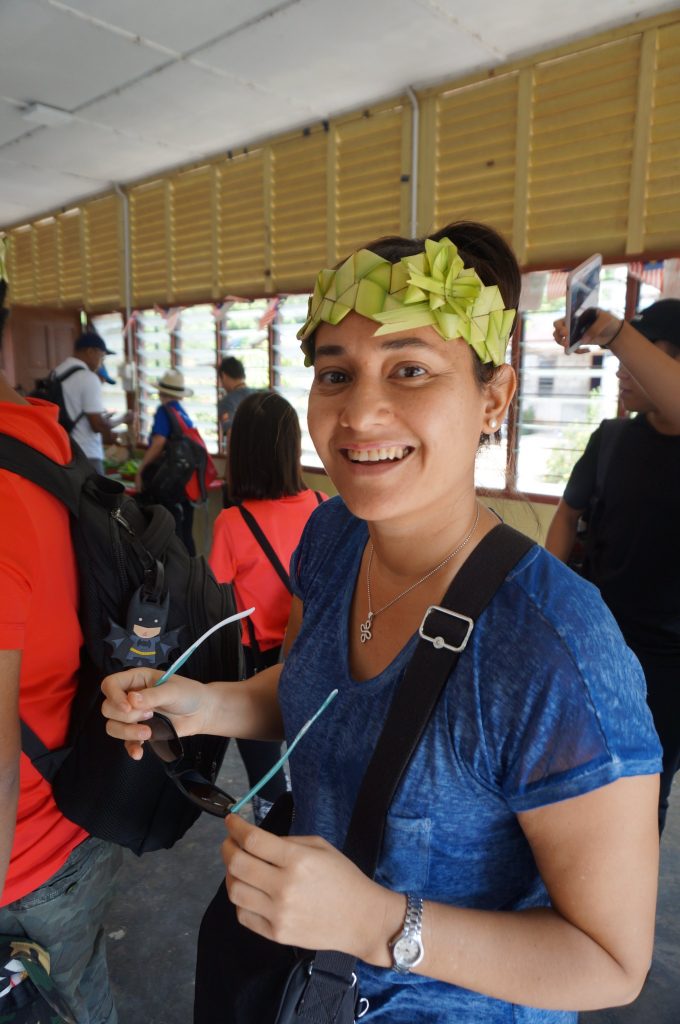
Today, Jenita is the bridge that connects urban Malaysians and indigenous tribes. With a broad smile, Jenita walks towards Dr. Gaik and shakes hands with her to welcome our entourage. She leads everyone into the Balai Raya (village hall) where kampong residents stand waiting with welcoming gifts: the traditional Temuan handcrafted headband known as “Talik Dendan”. All of us are really excited and take turns wearing the Talik Dendan.
After exchanging pleasantries, Jenita introduces all of us to the village representative and village chief. The village representative steps up and Jenita says, “You can call him Mamat, it means uncle in our language”. Mamat is a plump middle aged man dressed in a blue t-shirt; he extends his hands and waves at us. For a moment, they all stand shyly in front of us. “Welcome to our Kampung,” says the village chief, after a brief silence.
Labels of Love
Once the introductions are over, Jenita leads us to a long table full of jungle herbs, roots, vegetables and herbs, all neatly labeled and categorized as Ulam, Vegetables, Flavouring and Medicinal Herbs.
“Our jungles have incredible ingredients,” says Jenita. “We’ve prepared some of them here to teach you about them.”
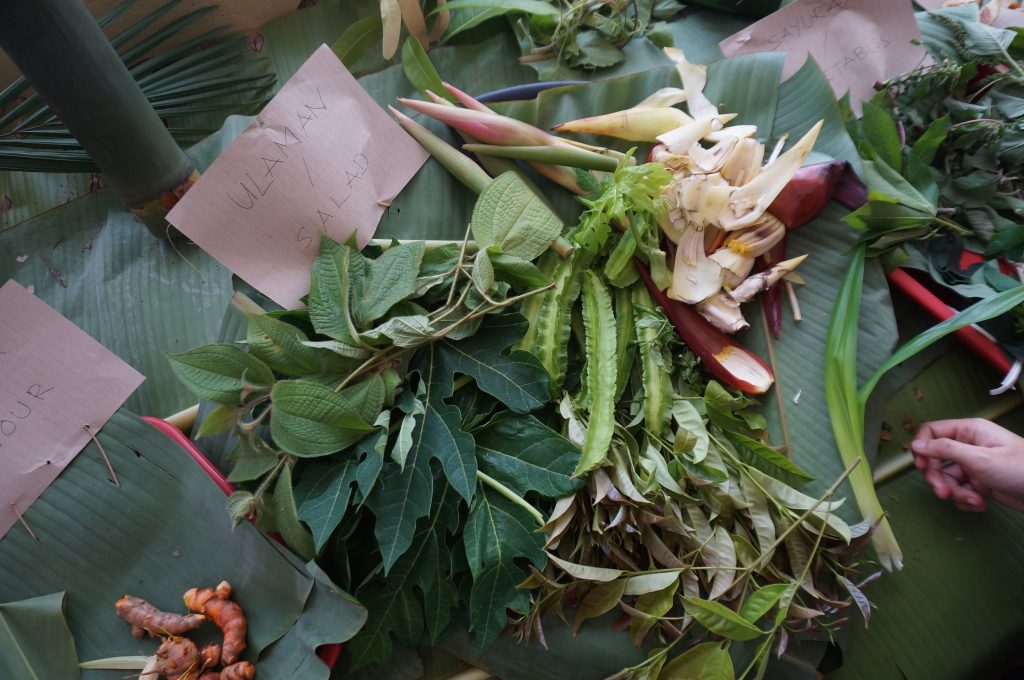
Temuan Ulam
Ulam is a traditional Malaysian salad that comprises of fresh leaves, vegetables or fruits that can be eaten raw or after being soaked in hot water. Like the Malay community, the Temuan consumes ulam with a generous serving of sambal.
1. Pucuk Ketik Anjing and Pucuk Betik
Pucuk ketik anjing scientific name and family: unknown.
Pucuk Betik scientific name: Carica
Family: Caricaceae
Other names: Papaya Leaves
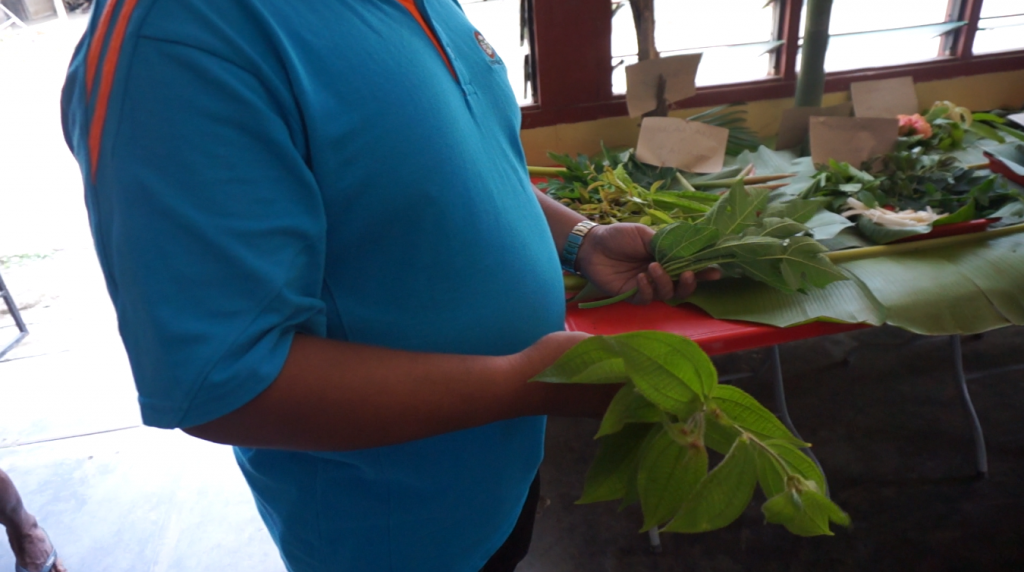
Jenita points a small plant with soft looking leaves. “This one is not for cooking. If I’m not wrong, this is called pucuk ketik anjing. We normally boil with pucuk betik to reduce its bitterness.” She pauses thoughtfully and turns to Mamat to allow him to explain further.
Mamat holds up both the plants in his hands. “Pucuk betik is bitter, so pucuk ketik anjing makes it less bitter. We drink it because it is medicinal and it helps with diabetes, dengue and high blood pressure. By the way, papaya leaves that are drier are better and more suited for those with blood pressure problems. Just boil the leaves and drink it like tea,” he explains.
2. Daun Salam
Scientific name: Syzygium polyanthum
Family: Myrtaceae
Other names: Indian Bay Leaf, Indonesian Bay Leaf

We see Mamat pick another young plant from the table. “This is called daun salam. It part of our ulam, we normally eat the leaves with sambal,” he says. “Ulam is an important part of our diet, and we normally have it with rice.”
In Sumatra, Java, Madura or Bali, these leaves are used dried or fresh. Dried leaves are normally steeped as a medicinal tea to help reduce stress, flu, fever, infection and insomnia. Both Malaysian and Indonesian cuisine use daun salam when making various rice, meat or vegetable dishes.
3. Kacang Botol
Scientific name: Psophocarpus tetragonolobus
Family: Fabaceae
Other names: Four angled bean, Goa bean, four angled bean, four cornered bean, manila bean, dragon bean, 四角豆 (Chinese: si-jiao-dou)
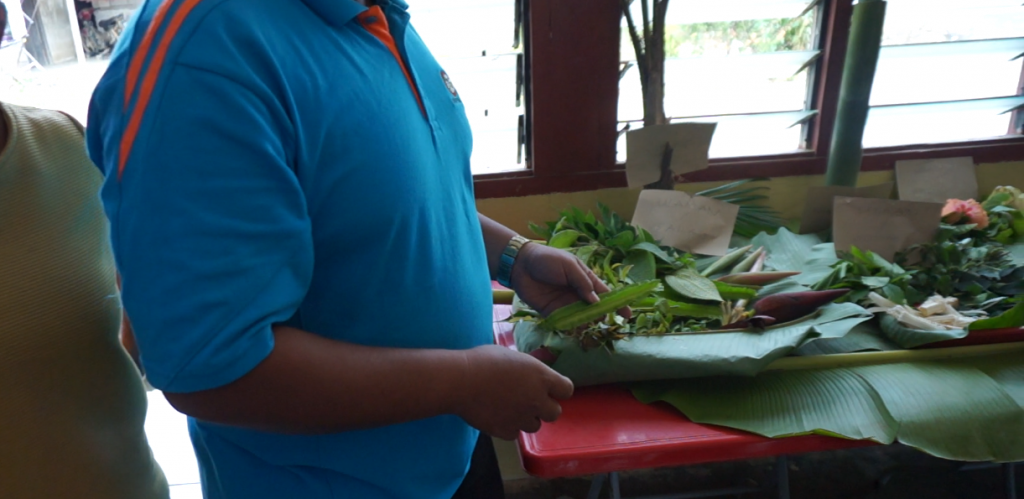
It is difficult to understate just how similar the Temuan ulam is to the rest of Malaysia, or Asia for that matter. Most of the herbs can be found in Thailand, Indonesia to as far as the Philippines. Mamat picks up the familiar four-angled bean, known as Kacang Botol to Malaysians, and adds “We eat this as a raw salad with sambal!”
We have a taste of this raw vegetable. It has a refreshing, crunchy and light vegetal flavour. The leaves, flowers, roots and bean pods of the four-angled bean can be eaten raw or cooked. In Asia, they are eaten as a salad, stir fried or made into stew. The beans are rich in protein, tocopherols, vitamin A, C, calcium, iron and other nutrients.
4. Jantung Pisang and Bunga Kantan
Jantung Pisang Scientific name: Musa
Family: Musaceae
Other names: Banana blossom, Banana flower, Jantung Pisang (Malay)
Bunga Kantan Scientific name: Etlingera elatior
Family: Zingiberaceae
Other names: Ginger Torch Flower, Bunga kecombrang (Indonesian), Bunga Kantan (Malay), Philippine wax flower, 火炬姜 (Chinese: Huǒjù jiāng),
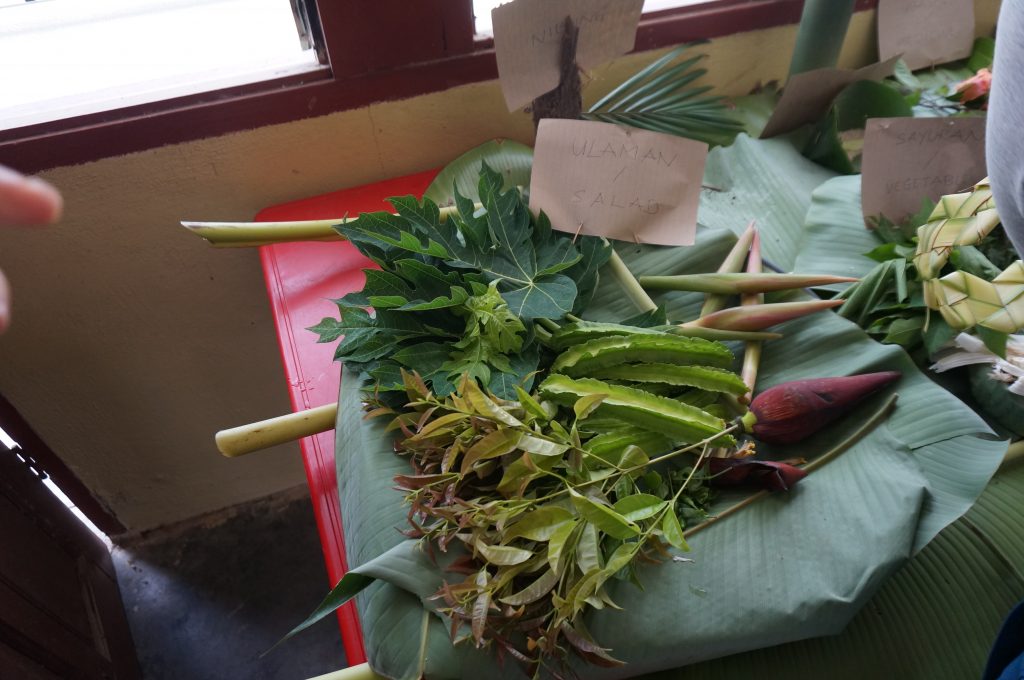
Jantung Pisang literally means the heart of the banana in Bahasa Malaysia. It is an elongated flower bud with deep reddish hues. To eat it, you will need to peel out the outer buds to get to the underdeveloped florets at the heart of the banana flower. The way the Temuan prepare jantung pisang is similar to the Malays. Banana florets are blanched lightly before being served as ulam with sambal.
“It is also safe to eat it raw,” says Jenita as she peels it and offers the florets to all of us. In its raw form, it has a light and delicate taste, which is less-banana-like in flavour. “We foraged this from pokok pisang emas or in my community, we call this pisang minyak,” says Jenita, referring to local names for a specific type of banana tree.
An Indonesian participant in our group reached out and gently touched the pink flower next to Jantung Pisang and says, “In Indonesia, we call this bunga kecombrang and we eat this with sliced chilli, tomato and coconut oil.” Jenita beams and answers, “Well here, we call this bunga kantan, we normally just slice this thinly and squeeze some lemon juice on it and it tastes perfect as it is. Here in the jungle, tomatoes are not our native food.”
Temuan Vegetables
Quite frankly, what the Temuan consider as vegetables will surprise you. Jungle produce contains a rich source of fruit, nuts, roots and edible plants. These contribute to the indigenous people diet. The Temuan shared with us a few jungle vegetables that are common to their diet.
1. Pucuk Nibong
Scientific name: Oncosperma tigilarium
Family: Arecaceae
Other names: Nibung (Indonesian), Anibung (Philippines)

“Pucuk Nibong is a wild palm tree in the forest that kind of looks like a coconut tree. These are palm shoots,” says Jenita. We take a bite and find that it is soft, tasty and strangely addictive.
“How did you harvest these?” asks one of the participants.
“We cut the bark of the young palm tree to extract these,” answers Mamat.
It may sound surprising, but to the Temuan, the barks of young palms are a source of food. In fact, palms like pantu, nipah, nibong, coconut and sago are delicacies to the indigenous people of Malaysia. It is usually boiled and served alongside other cooked forest produce.
2. Pucuk Ubi
Scientific name: Ipomoea batatas
Family: Convolvulaceae
Other names: Fan Su Ye (China), Talbos ng Camote (Tagalog)
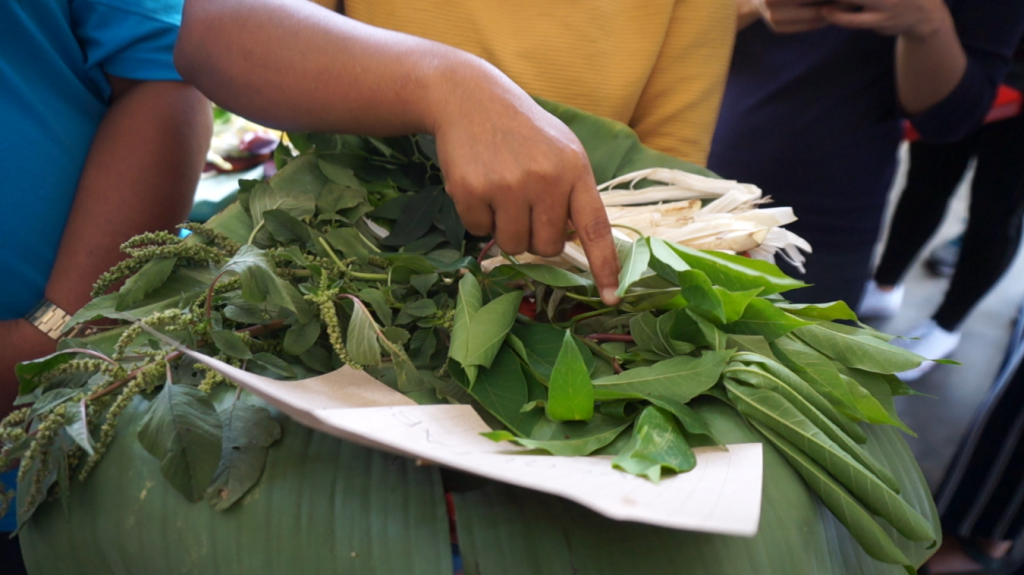
Moving to the tender shoots next to the pucuk nibong, Jenita explains, “These are tapioca leaves or pucuk ubi, you can eat both the leaves and roots. It’s great when add some oil and stir-fry them. We also cook them a lot with meat.”
Pucuk ubi is packed with nutrients like vitamins, dietary fiber, and essential fatty acids. It also contains protein, minerals, vitamin b, beta carotene, lutein and antioxidants. It is a rich support for blood clot, heart ailments, bone density, brain health, gum health and inflammation.
3. Pucuk Bayam
Scientific name: Amaranthus
Family: Amaranthaceae
Other names: Bayam (Malaysia and Indonesia), Kalunay/Kulitis (Philippines), Chaulai/Cheera/Mulaikkira (India), rau dền (Vietnam)

Few vegetables are as common as Pucuk Bayam, known to Malaysians as spinach. According to Jenita, we must be careful while preparing this. “Notice how there are thorns on the plant?” says Jenita.
Cooked pucuk bayam leaves are a rich source of vitamin A, C, calcium and manganese with moderate levels of folate, iron, magnesium and potassium. In Asia, it is normally stir-fried or made into soups or curries.
4. Pucuk Manis
Scientific name: Sauropus androgynous
Family: Phyllanthaceae
Other names: Sweet leaf, mani cai (马尼菜, Chinese), amame shiba (アマメシバ, Japanese), cekur manis, sayur manis, asin-asin or cangkok manis (Brunei) and pak waan (Thai).
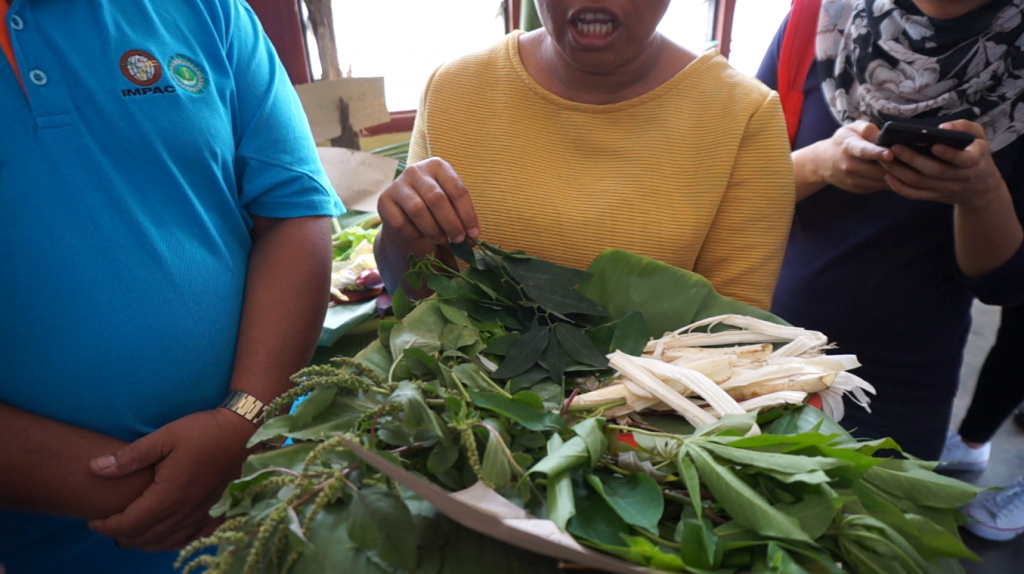
“I don’t know its scientific name, but in my community, we call this pucuk manis,” says Jenita, referring to the star gooseberry or sweet leaf. It’s a tropical leafy vegetable that can be found in both South Asia and Southeast Asia and is popular because of its of high yields and palatability. The pucuk manis is commonly served as a stir fry in Malaysia. While in Indonesia, the leaves are used as a traditional remedy to improve the flow of breast milk for breastfeeding mothers.
Freshly plucked pucuk manis is high in provitamin A carotenoids. The leaves also contain high levels of vitamin B and C, protein and minerals. It’s no wonder that the Orang Asli are always healthy!
Temuan Flavouring
Although indigenous cooking is known to honour the inherent flavours of food, the Temuan do use natural flavouring. Here, Jenita shows us three plants they use to flavour food: daun semomok, kunyit (turmeric) and daun pandan.
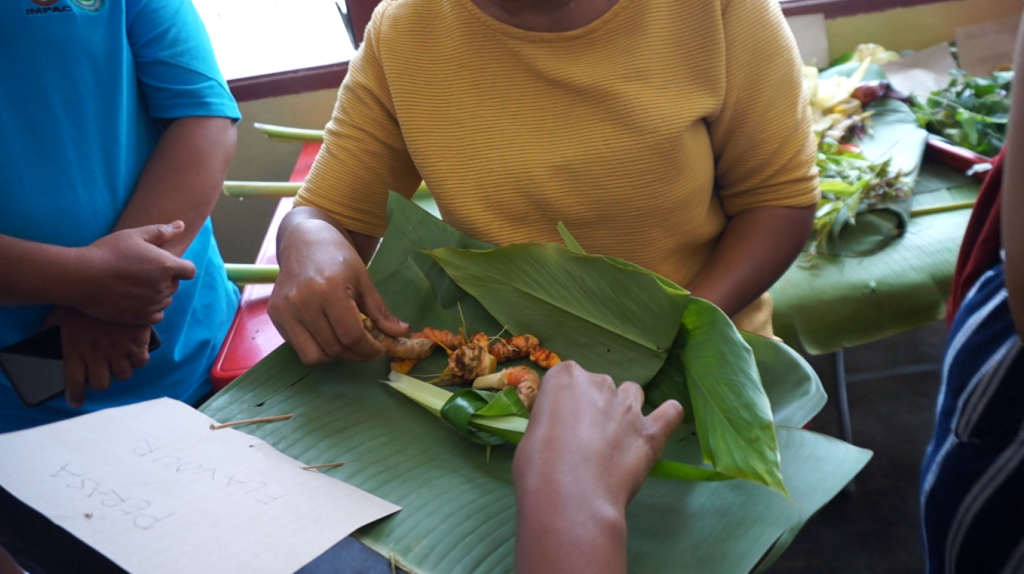
1. Daun Semomok
Scientific name: Elettariopsis curtisii
Family: Zingiberacea
Other names: Pokok pepijat, pijat-pjat, cemomok (Malay)
Daun Semomok is thick, large and leafy green in appearance. It hides a complex flavour that is a cross between cilantro and mint. The locals say that when you do cook the daun semomok though, it does have its own special flavour. Jenita hands it to everyone for quick whiff and many of us are taken aback by its strong smell.
A study by local scientists uncovered that the essential oils of daun semomok or elettariopsis curtisii (Zingiberaceae) contain antimicrobial activities (Source: H. Ibrahim , D. R. Syamsir , A. N. Aziz , K. Awang , M. A. Nor Azah , M. Mastura). This species is also a genus of plants native Southeast Asia, Southern China and New Guinea.
2. Kunyit (Tumeric)
Scientific name: Curcuma longa
Family: Zingiberaceae
Other names: Kunyit (Malay), Haridra (Indian), açafrão(Portugese), 姜黄(Chinese: jiānghuáng), ターメリック (Japanese). More here.
Tumeric or kunyit is a root essential in Asian cooking. It is also used for dyeing. Identifiable through its brilliant yellow colour, tumeric adds flavour to many curry dishes. Malaysians use kunyit a lot when frying up meat. This popular herb has a warm, bitter, black pepper-like flavour and an earthy, mustard-like aroma. This edible root is used fresh or boiled in water and dried, after which it is can be ground into a deep orange-yellow powder commonly used for cooking or as medicine. Tumeric is long used in Aryuvedic and traditional Chinese medicine, where it is also known as an anti-inflammatory agent.
3. Daun Pandan
Scientific name: Pandanus amaryllifolius
Family: Pandanaceae
Other names: Screwpine, rampé (India and Sri Lanka), pulao pata (Bangladesh), ran’baa (Maldives) and Bai Toey (Thailand)
Pandanus amaryllifolius is a tropical plant in the Pandanus (screwpine) genus. In Southeast Asia it is often used to flavour desserts, kuih and sweet beverages. The Temuan tribe uses daun pandan to flavour rice. The leaves are normally knotted, thrown into pot and boiled with rice.
Temuan Medicinal Herbs
Medicine to the Temuan is different from urban folk. If they needed a remedy, they would just pluck it from their garden or forage it from the jungle. Application is easy. Selected leaves or flowers are squished to release liquid and essential oils that can provide medicinal relief.
1. Sambang Tunggul (Pucuk Gentam/Daun Gentam)
Scientific name and family: Unknown
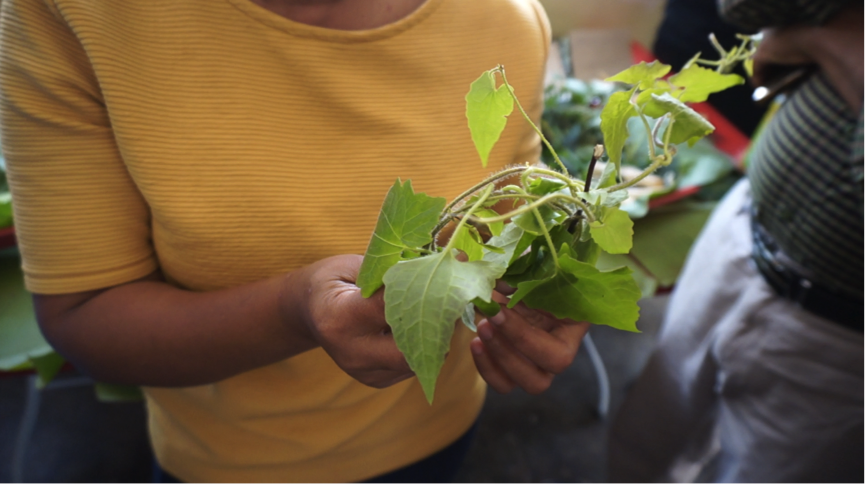
What do you do when you have a cut? Is there an indigenous remedy that is equivalent to Dettol cream? Jenita shows us the Sambang Tunggul a.k.a. Pucuk Gentam. Indigenous tribes would pluck its leaves and crush it by rolling it in between their palms. The bruised leaves secrete a greenish liquid that helps heal cuts and stops the wound from bleeding! According to Mamat, it is also commonly used to treat dandruff. “My mother used to mix sambang tunggul into coconut oil, and when the residue of this herb floats up, we will just use this as a beauty mask. It smells really good!” says Jenita.
2. Daun Pauh
Scientific name: Mangifera indica L. (Anacardiaceae)
Family: Anacardiaceae
Other names: Daun Paun (Malaysia), Wani (Balinese), Yaa-Lam (Thai), Bayuno (Philipines)
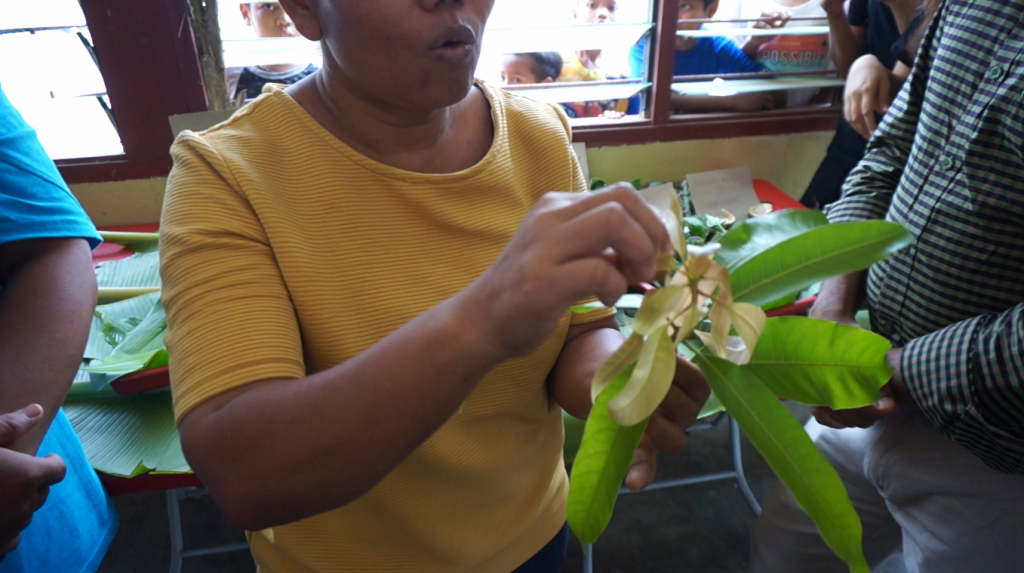
Medicine looks a lot like food in the Temuan community. Jenita picks up a branch full of narrow leaves. “This is from a mango species,” she says as she plucks out a young leaf and chews on it. “We use the daun pauh to treat skin diseases, but I personally sometimes like to eat them,” she adds with a grin.
Daun Pauh’s scientific name is mangifera caesia, a flowering plant in the cashew family, anacardiaceae. It is native to the Indian continent and brought to East Asia in 400 – 500BCE. Today, this species can be found in Pakistan, Bangladesh, Thailand, Malaysia, Indonesia and Philippines.
3. Betel Leaf and Nut
Scientific Name: Piper betle, Areca Nut
Family: Piperaceae
Other names: Sireh (Malay), Pinang (Malay), Paan (Sanskrit)

“Whenever we welcome people, we will present them with this leaf and nut. Do you know what this is?” asks Jenita.
“It’s betel nut and leaf!” says an Indian participant.
“Correct!” says Jenita. “In our community, we also use the betel leaf to treat cuts, sore throat and high blood pressure. However, chewing some betel leaves will makes you feel giddy. The interesting thing is, that many years ago, our betel nut leaves had a pandan flavour and smell, sadly, the we don’t have that anymore.”
Betel nut and leaves are usually served to guests or to the community after meals. It serves as a mouth freshener, aids digestion and creates a sense of giddy euphoria. However, chewing betel nut also tends to stain the teeth red. Betel chewing is said to be over 2,000 years old has been practiced in South Asia and South East Asia for a very long time.
4. Bunga Raya
Scientific name: Hibiscus rosa-sinensis
Family: Malvaceae
Other names: Kembang sepatu, Bebaru (Malay), China Rose, Rose of China, Hawaiian hibiscus, Rose mallow and shoeblackplant (Hawaii).
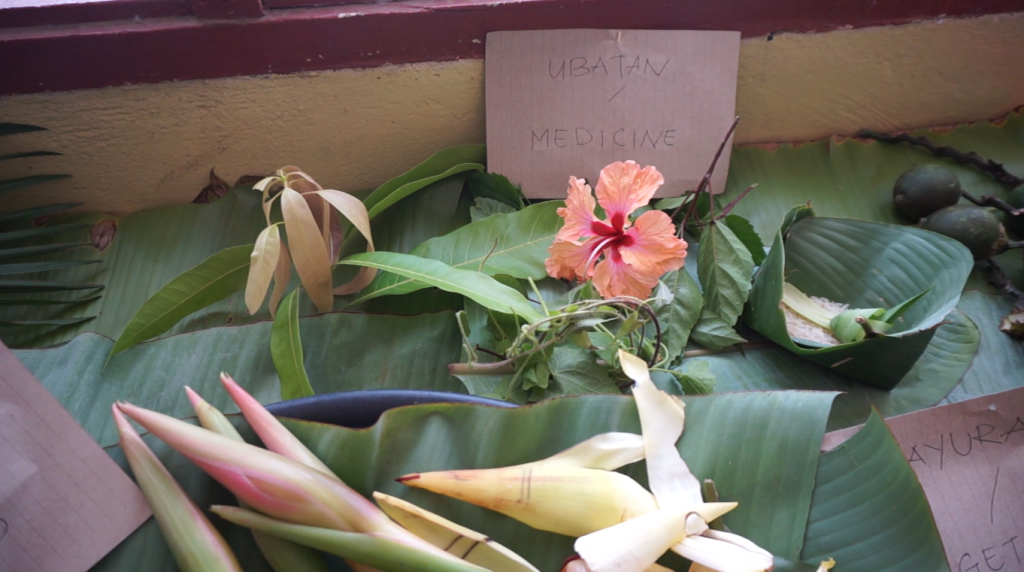
Beyond just being Malaysia’s national flower, the Bunga Raya is often used in traditional medicine. “The Temuan community would normally crush the bunga raya and use it to treat dandruff,” says Jenita.
Bunga Raya is also commonly used in Malaysia as food with a flavour akin to a refreshing lemon tart. In Malay traditional medicine, this edible flower is used to cool the body, eliminate excess fluid in the body, treat urinary disorder, cancer, constipation, cough, cystitis, debility, diarrhoea, dysentery, dysmenorrhea, fever, menstrual disorder and hair loss.
Orang Asli Cuisine is Healthy.
After Jenita and Mamat’s presentation, the participants are left to explore and taste these freshly picked jungle produce. Some of the edible plants are an immediate hit, and is consumed very quickly.
“Orang Asli cuisine is very healthy. I find that when I moved from the city, back to the jungle, I got sick less. I think it’s because our cooking is simple. We don’t add any refined sugar, salt, oil or any additives. All our vegetables and meat are always cooked fresh,” says Jenita. This is a valuable lesson to all of us. Perhaps we should take a leaf from Orang Asli cuisine – and consume healthier options from time to time.
